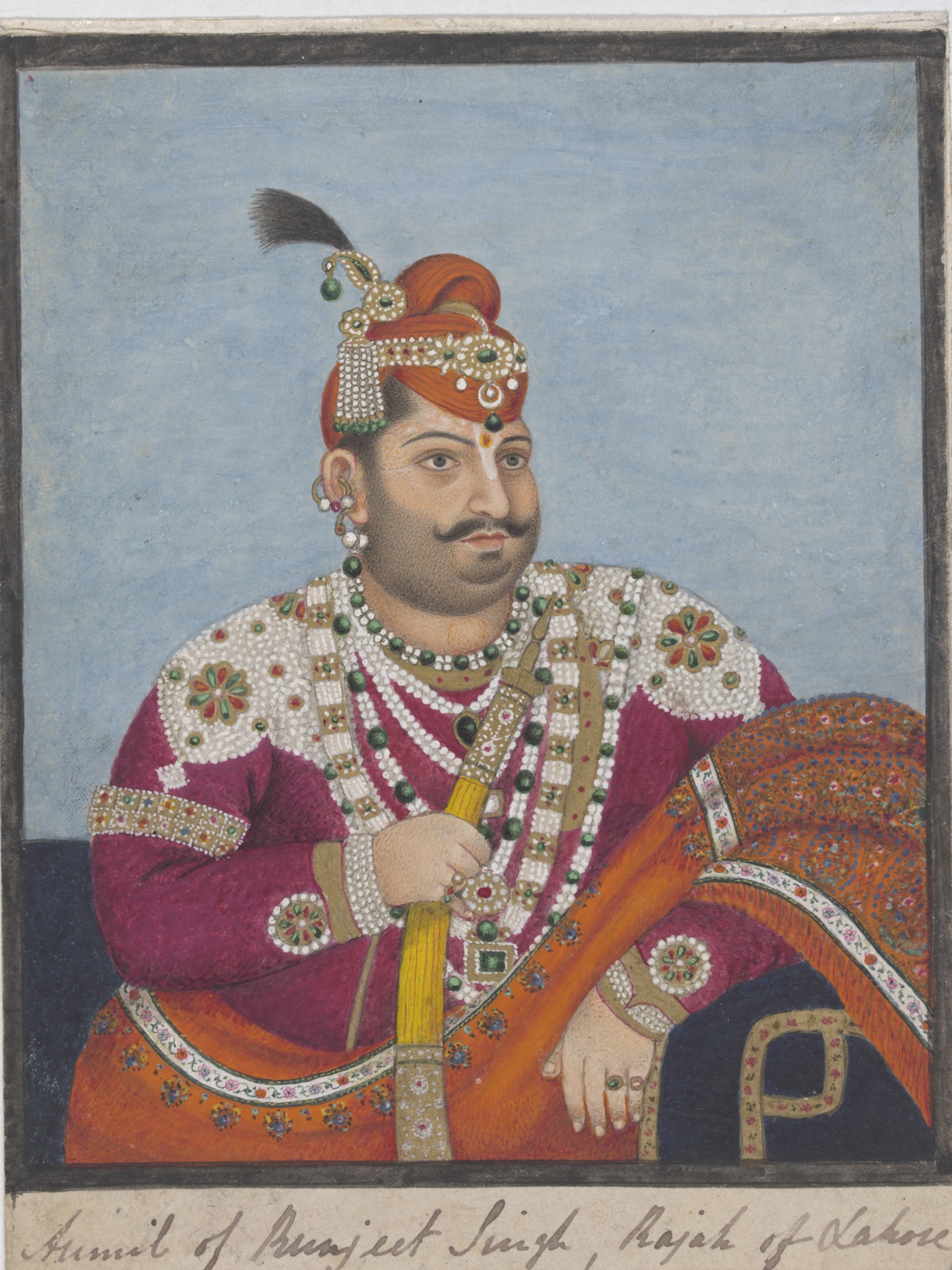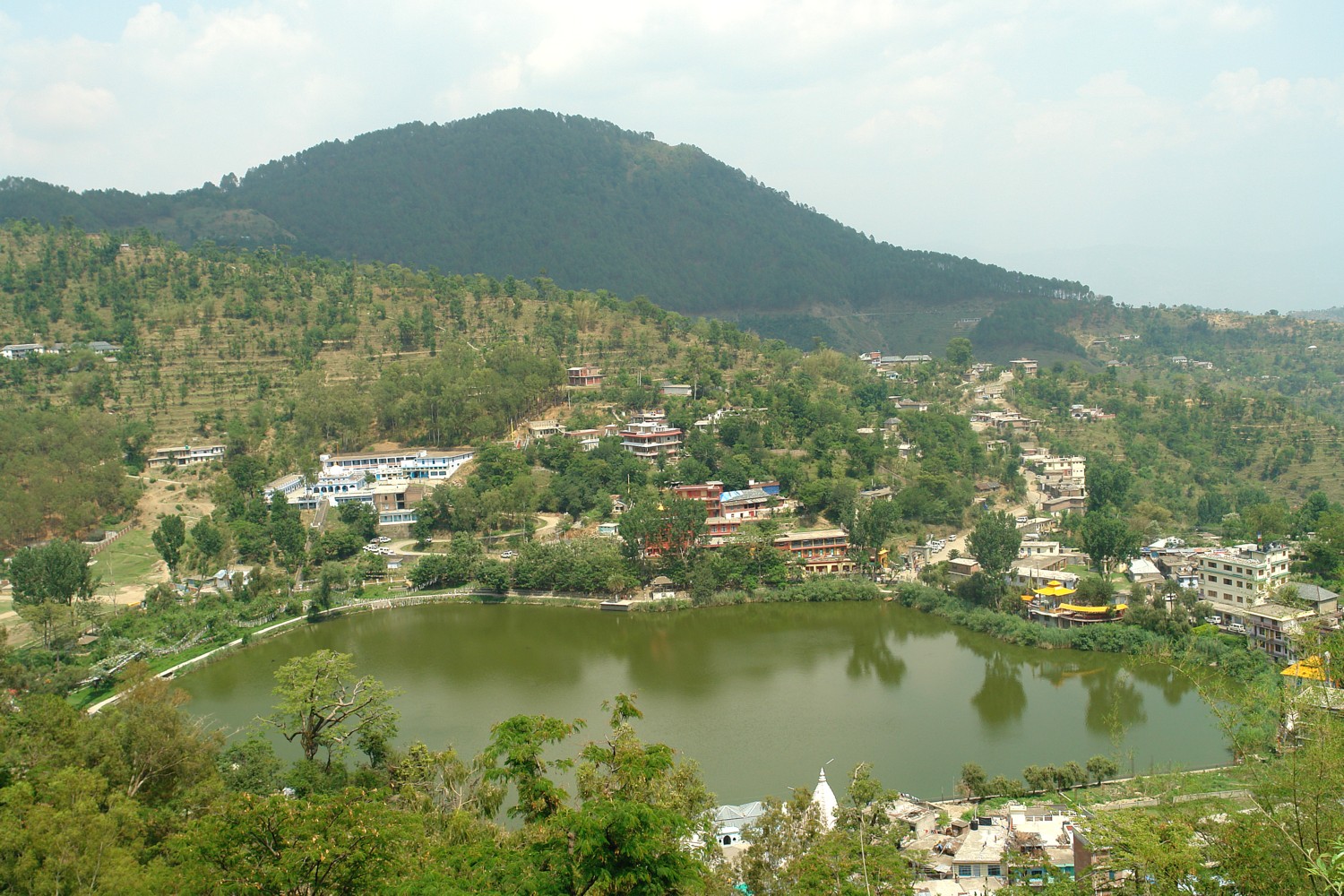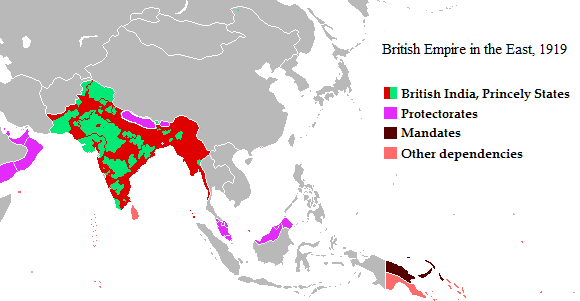|
Mandi State
Mandi State was a native state of British India, within the Punjab; with Mandi, Himachal Pradesh as its capital. The state of Mandi (the name means "market" in Hindi), which included two towns and 3,625 villages, was part of the States of the Punjab Hills. It was located in the Himalayan range, bordering to the west, north, and east on the British Punjabi district of Kangra; to the south, on Suket; and to the southwest, on Bilaspur. As of 1941, population of Mandi State was 232,598 and area of the state was . History The predecessor state of Siokot was founded in 1527. Formerly part of the Kingdom of Suket in the Punjab Hills, the dynasty traditionally goes back to 765AD. In about 1100, Vijaya Sen had two sons, Sahu Sen who ruled over Suket and Bahu Sen who ruled over Kullu. Bahu Sen’s descendants emigrated to Kullu until the tenth descendant, Kabakha Sen was killed by the Raja of Kullu and his son had to flee to Siokot, not very far from the present city of Mandi which w ... [...More Info...] [...Related Items...] OR: [Wikipedia] [Google] [Baidu] |
British India
The provinces of India, earlier presidencies of British India and still earlier, presidency towns, were the administrative divisions of British governance on the Indian subcontinent. Collectively, they have been called British India. In one form or another, they existed between 1612 and 1947, conventionally divided into three historical periods: *Between 1612 and 1757 the East India Company set up Factory (trading post), factories (trading posts) in several locations, mostly in coastal India, with the consent of the Mughal emperors, Maratha Empire or local rulers. Its rivals were the merchant trading companies of Portugal, Denmark, the Netherlands, and France. By the mid-18th century, three ''presidency towns'': Madras, Bombay and Calcutta, had grown in size. *During the period of Company rule in India (1757–1858), the company gradually acquired sovereignty over large parts of India, now called "presidencies". However, it also increasingly came under British government over ... [...More Info...] [...Related Items...] OR: [Wikipedia] [Google] [Baidu] |
Mandi District
Mandi district is one of the central districts of Himachal Pradesh state in northern India. The town of Mandi is the headquarters of the district. The main native language is Mandeali. As of 2011 it is the second most populous district of Himachal Pradesh (out of 12), after Kangra. Demographics According to the 2011 census Mandi district has a population of 999,777, roughly equal to the nation of Fiji or the US state of Montana. This gives it a ranking of 446th in India (out of a total of 640). The district has a population density of . Its population growth rate over the decade 2001-2011 was 10.89%. Mandi has a sex ratio of 1012 females for every 1000 males and a literacy rate of 82.81%. At the 2011 census, 59% of the population in the district identified their first language as Mandeali, 33% opted for Pahari (a term broadly applicable to most Indo-Aryan languages of Himachal and Uttarakhand), while 4.1% chose Hindi, 0.66% – Punjabi and 0.47% – Kangri. Subd ... [...More Info...] [...Related Items...] OR: [Wikipedia] [Google] [Baidu] |
Political Integration Of India
After the Indian independence in 1947, the dominion of India was divided into two sets of territories, one under direct British rule, and the other under the suzerainty of the British Crown, with control over their internal affairs remaining in the hands of their hereditary rulers. The latter included 562 princely states, having different types of revenue sharing arrangements with the British, often depending on their size, population and local conditions. In addition, there were several colonial enclaves controlled by France and Portugal. The political integration of these territories into an Indian Union was a declared objective of the Indian National Congress, and the Government of India pursued this over the next decade. Through a combination of factors, Sardar Vallabhbhai Patel and V. P. Menon coerced and coalesced the rulers of the various princely states to accede to India. Having secured their accession, they then proceeded, in a step-by-step process, to secure and exte ... [...More Info...] [...Related Items...] OR: [Wikipedia] [Google] [Baidu] |
1948 Disestablishments In India
Events January * January 1 ** The General Agreement on Tariffs and Trade (GATT) is inaugurated. ** The Constitution of New Jersey (later subject to amendment) goes into effect. ** The railways of Britain are nationalized, to form British Railways. * January 4 – Burma gains its independence from the United Kingdom, becoming an independent republic, named the ''Union of Burma'', with Sao Shwe Thaik as its first President, and U Nu its first Prime Minister. * January 5 ** Warner Brothers shows the first color newsreel (''Tournament of Roses Parade'' and the ''Rose Bowl Game''). ** The first Kinsey Report, ''Sexual Behavior in the Human Male'', is published in the United States. * January 7 – Mantell UFO incident: Kentucky Air National Guard pilot Thomas Mantell crashes while in pursuit of an unidentified flying object. * January 12 – Mahatma Gandhi begins his fast-unto-death in Delhi, to stop communal violence during the Partition of India. * January 17 &nda ... [...More Info...] [...Related Items...] OR: [Wikipedia] [Google] [Baidu] |
1290 Establishments In Asia
1 (one, unit, unity) is a number representing a single or the only entity. 1 is also a numerical digit and represents a single unit of counting or measurement. For example, a line segment of ''unit length'' is a line segment of length 1. In conventions of sign where zero is considered neither positive nor negative, 1 is the first and smallest positive integer. It is also sometimes considered the first of the infinite sequence of natural numbers, followed by 2, although by other definitions 1 is the second natural number, following 0. The fundamental mathematical property of 1 is to be a multiplicative identity, meaning that any number multiplied by 1 equals the same number. Most if not all properties of 1 can be deduced from this. In advanced mathematics, a multiplicative identity is often denoted 1, even if it is not a number. 1 is by convention not considered a prime number; this was not universally accepted until the mid-20th century. Additionally, 1 is ... [...More Info...] [...Related Items...] OR: [Wikipedia] [Google] [Baidu] |
13th-century Establishments In India
The 13th century was the century which lasted from January 1, 1201 ( MCCI) through December 31, 1300 ( MCCC) in accordance with the Julian calendar. The Mongol Empire was founded by Genghis Khan, which stretched from Eastern Asia to Eastern Europe. The conquests of Hulagu Khan and other Mongol invasions changed the course of the Muslim world, most notably the Siege of Baghdad (1258), the destruction of the House of Wisdom and the weakening of the Mamluks and Rums which, according to historians, caused the decline of the Islamic Golden Age. Other Muslim powers such as the Mali Empire and Delhi Sultanate conquered large parts of West Africa and the Indian subcontinent, while Buddhism witnessed a decline through the conquest led by Bakhtiyar Khilji. The Southern Song dynasty would begin the century as a prosperous kingdom but would eventually be invaded and annexed into the Yuan dynasty of the Mongols. The Kamakura Shogunate of Japan would be invaded by the Mongols. Goryeo resist ... [...More Info...] [...Related Items...] OR: [Wikipedia] [Google] [Baidu] |
History Of Himachal Pradesh (1947–present)
Himachal Pradesh was established in 1948 as a Chief Commissioner's Province within the Union of India. The province comprised the hill districts around Shimla and southern hill areas of the former Punjab region. Himachal became a part C state on 1951 with the implementation of the Constitution of India. Himachal Pradesh became a Union Territory on 1 November 1956. On 18 December 1970 the State of Himachal Pradesh Act was passed by Parliament and the new state came into being on 25 January 1971. Thus Himachal emerged as the eighteenth state of the Indian Union. In earlier times, the area was variously divided among smaller kingdoms, such as those of Chamba, Bilaspur, Bhagal and Dhami. After the Gurkha War of 1815–1816, it became part of the British India. Pre-Independence Prehistory Some evidences have been found that nearly 2 million years ago man lived in the foothills of Himachal Pradesh. Bangana valley of Kangra, ''Sirsa'' valley of Nalagarh and ''Markanda'' valle ... [...More Info...] [...Related Items...] OR: [Wikipedia] [Google] [Baidu] |
List Of Indian Princely States
Before the Partition of India in 1947, about 584 princely states, also called "native states", existed in India, which were not fully and formally part of British India, the parts of the Indian subcontinent which had not been conquered or annexed by the British but under indirect rule, subject to subsidiary alliances. Things moved quickly after the partition of British India in 1947. By the end of 1949, all of the states had chosen to accede to one of the newly independent states of India or Pakistan or else had been conquered and annexed. Outline In principle, the princely states had internal autonomy, while by treaty the British Crown had suzerainty and was responsible for the states' external affairs. In practice, while the states were indeed ruled by potentates with a variety of titles, such as Maharaja, Raja, Nizam, Raje, Deshmukh, Nawab, Mirza, Baig, Chhatrapati, Khan, Thakur Sahab, Darbar saheb or specially Jam for Jadeja/Samma, the British still had considerable ... [...More Info...] [...Related Items...] OR: [Wikipedia] [Google] [Baidu] |
Joginder Sen
Raja Sir Joginder Sen Bahadur KCSI (20 August 1904 – 16 June 1986) was the last ruling Raja of Mandi State, and was subsequently a diplomat and Member of Parliament. Life Joginder Sen succeeded to the Mandi throne on 28 April 1913, aged eight. On 18 February 1925, he received an honorary commission as a lieutenant in the British Indian Army. Knighted as a Knight Commander of the Order of the Star of India (KCSI) in the 1931 New Year Honours list, he was promoted to honorary captain on 26 September 1931 and to honorary major on 24 December 1938. He received his final promotion to honorary lieutenant-colonel on 15 October 1946, and received an honorary commission in the same rank in the post-Independence Indian Army on 18 January 1951. After serving as Ambassador to Brazil, Raja Joginder Sen represented the Mandi constituency in the Lok Sabha The Lok Sabha, constitutionally the House of the People, is the lower house of India's bicameral Parliament, with the upper ho ... [...More Info...] [...Related Items...] OR: [Wikipedia] [Google] [Baidu] |
Raja
''Raja'' (; from , IAST ') is a royal title used for South Asian monarchs. The title is equivalent to king or princely ruler in South Asia and Southeast Asia. The title has a long history in South Asia and Southeast Asia, being attested from the Rigveda, where a ' is a ruler, see for example the ', the "Battle of Ten Kings". Raja-ruled Indian states While most of the Indian salute states (those granted a gun salute by the British Crown) were ruled by a Maharaja (or variation; some promoted from an earlier Raja- or equivalent style), even exclusively from 13 guns up, a number had Rajas: ; Hereditary salutes of 11-guns : * the Raja of Pindrawal * the Raja of Morni * the Raja of Rajouri * the Raja of Ali Rajpur * the Raja of Bilaspur * the Raja of Chamba * the Raja of Faridkot * the Raja of Jhabua * the Raja of Mandi * the Raja of Manipur * the Raja of Narsinghgarh * the Raja of Pudukkottai * the Raja of Rajgarh * the Raja of Sangli * the Raja of Sailana * the Raj ... [...More Info...] [...Related Items...] OR: [Wikipedia] [Google] [Baidu] |
Playing Trumpet At Temple
Play is a range of Motivation#Incentive theories: intrinsic and extrinsic motivation, intrinsically motivated activities done for recreational pleasure and enjoyment. Play is commonly associated with children and juvenile-level activities, but may be engaged in at any life stage, and among other higher-functioning animals as well, most notably mammals and birds. Many prominent researchers in the field of psychology, including Melanie Klein, Jean Piaget, William James, Sigmund Freud, Carl Jung and Lev Vygotsky have erroneously viewed play as confined to the human species, believing play was important for human development and using different research methods to prove their theories. Play is often interpreted as frivolous; yet the player can be intently focused on their objective, particularly when play is structured and goal-oriented, as in a game. Accordingly, play can range from relaxed, free-spirited and spontaneous through frivolous to planned or even compulsive. Play is not ... [...More Info...] [...Related Items...] OR: [Wikipedia] [Google] [Baidu] |
Playing Horn At Palace Temple
Play is a range of Motivation#Incentive theories: intrinsic and extrinsic motivation, intrinsically motivated activities done for recreational pleasure and enjoyment. Play is commonly associated with children and juvenile-level activities, but may be engaged in at any life stage, and among other higher-functioning animals as well, most notably mammals and birds. Many prominent researchers in the field of psychology, including Melanie Klein, Jean Piaget, William James, Sigmund Freud, Carl Jung and Lev Vygotsky have erroneously viewed play as confined to the human species, believing play was important for human development and using different research methods to prove their theories. Play is often interpreted as frivolous; yet the player can be intently focused on their objective, particularly when play is structured and goal-oriented, as in a game. Accordingly, play can range from relaxed, free-spirited and spontaneous through frivolous to planned or even compulsive. Play is not ... [...More Info...] [...Related Items...] OR: [Wikipedia] [Google] [Baidu] |










.jpg)